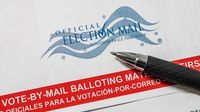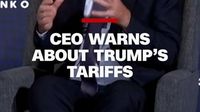President Donald Trump has once again thrust the nation’s election system into the spotlight, announcing this week his intent to sign an executive order that would eliminate mail-in voting—and even voting machines—across the United States ahead of the 2026 midterm elections. The announcement, made both on social media and at the White House, has ignited debate from coast to coast, with state officials, legal scholars, and voters scrambling to understand what such a sweeping change could mean for their ballots—and whether the president even has the authority to make it happen.
Trump’s renewed attack on mail-in ballots comes as no surprise to those who have followed his rhetoric in recent years. On social media, he wrote, “An executive order is being written right now by the best lawyers in the country to end mail-in ballots because they’re corrupt. And it’s time that the Republicans get tough and stop it because the Democrats want it. It’s the only way they can get elected.” According to reporting from The Texas Tribune, Trump described voting by mail as a “scam” and susceptible to voter fraud, despite the fact that U.S. courts have rejected dozens of fraud allegations since the 2020 election and elections officials consistently say voter fraud in the U.S. is exceptionally rare.
The legal basis for such an executive order is, at best, murky. The U.S. Constitution gives states—not the federal government—the power to set the “times, places and manner” of elections. As a result, any executive order from the president that attempts to override state election laws would almost certainly face immediate and significant legal challenges. In fact, many experts argue that presidents simply do not have the power to unilaterally change voting laws in this way. As The Texas Tribune notes, “Such an executive order from Trump would likely face legal challenges.”
Despite the legal uncertainty, the political impact of Trump’s announcement is already being felt. Mail-in ballots have become increasingly popular in the U.S., with roughly one-third of voters casting their ballots by mail rather than at a polling place. Eight states—California, Colorado, Hawaii, Nevada, Oregon, Utah, Vermont, and Washington—plus Washington, D.C., conduct all elections entirely by mail. Another 28 states allow “no-excuse absentee voting,” meaning any voter can request a mail-in ballot without providing a reason.
But the rules aren’t the same everywhere. Take Texas, for example. The state already places significant restrictions on who can vote by mail. According to The Texas Tribune, to be eligible for a mail-in ballot in Texas, voters must be at least 65 years old, sick or disabled, out of the country during early voting and on Election Day, expected to give birth three weeks before or after Election Day, or be confined in jail but otherwise eligible. And the state’s lawmakers have only tightened these restrictions in recent years. In 2022, Texas began requiring mail-in ballot applications to include proof of identification, a move that led to widespread confusion and thousands of rejected ballots that year.
The impact of these changes is evident in the numbers. In 2024, only 3% of registered Texas voters—fewer than 400,000 people—voted by mail, down from nearly 1 million in 2020. That’s a stark contrast to states like Arizona, California, Colorado, Oregon, Utah, and Washington, where at least three-fourths of voters cast their ballots by mail in the last general election. Texas Governor Greg Abbott summed up the prevailing sentiment among many state leaders in 2021: “We need to make sure that we have safety measures in place that prevent any type of fraud that could take place in the mail-in ballot system.”
Arkansas offers a different perspective on the issue. Reporting from 40/29 News highlights that the state relies on a stricter absentee ballot system, and local election officials are unsure whether Trump’s proposed executive order would even affect their process. Jennifer Price, director of elections for Washington County, explained, “For the general election in 2024, we had a little over 2,000 absentee voters. A lot of those were military and overseas citizens or voters who were unable to get to the polls because of disability or illness.” Unlike states that automatically send ballots to all registered voters, Arkansas requires residents to submit an application and provide a valid reason to vote absentee. County clerks then verify the voter’s registration before mailing a ballot. “You actually have to fill out an application stating your reason for voting,” Price said. “They verify that the voter is registered to vote, and then that voter receives their absentee ballot.”
Price also emphasized that any changes to Arkansas election procedures would come from the state level, not from county officials. “Our office won’t ever independently make decisions on the type of mail-in ballots or absentee voting,” she said. “We will get our directives from the Secretary of State’s Office and wait for them.” As of August 22, 2025, the Arkansas Secretary of State’s Office had not responded to requests for comment on how the proposed executive order might impact the state’s absentee voting process.
Trump’s opposition to mail-in voting marks a significant shift for the Republican Party. As The Texas Tribune recounts, Republicans once championed mail ballots. But after Trump lost the 2020 election—a year when 43% of registered voters cast ballots by mail because of the COVID-19 pandemic—he and other Republicans began to attack mail ballots, claiming without evidence that they contributed to widespread voter fraud. Courts, however, have repeatedly found no evidence to support these claims.
For states like Texas and Arkansas, where mail-in voting is already tightly regulated, the practical impact of Trump’s proposed executive order may be less dramatic than in states with more expansive mail-in or absentee voting systems. But the symbolic significance is hard to ignore. The push to restrict mail-in voting reflects broader national debates about election security, access, and the balance of power between state and federal governments.
As the 2026 midterms approach, voters, lawmakers, and election officials across the country are bracing for what could be another contentious battle over how Americans cast their ballots. With legal experts predicting a flurry of lawsuits should Trump attempt to implement his executive order, the final outcome remains uncertain. What is clear, however, is that the future of mail-in voting—and perhaps the very nature of American democracy—hangs in the balance.






